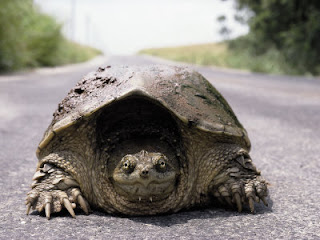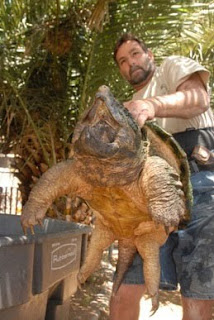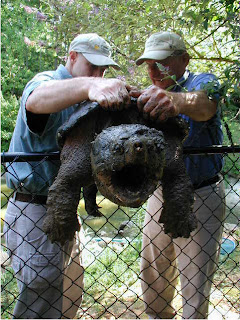 Baby Alligator Snapping Turtle
Baby Alligator Snapping TurtleLiving in rivers, lakes, rivers or other water bodies. The largest freshwater turtle in North America. Also found in the southern United States, Gulf of Mexico and the Mississippi River. Can stay under water for three hours, little drying in the sun. Women out of the water only to lay eggs.
 Alligator Snapping Turtle Front View
Alligator Snapping Turtle Front ViewLarge, dark brown and heavy head. Solid shell ridge three scales and spikes on the surface of carapace armor and give it a terrible appearance. Carapace is a combination of black, brown, gray and olive green surrounded, and the eye is the yellow line, to help them under the guise of water. Tarry, yellow, fleshy filaments (eyelashes) around the eyes.
 Giant Alligator Snapping Turtle
Giant Alligator Snapping TurtleThe average adult weight of 175 pounds (the heaviest one record of 236 pounds, Brookfield Zoo in Chicago suburbs). Long, muscular tail with a solid foundation. Now a lot of meat and skin warts. Webbed toe, tough claws. Plastron (lower shell) is less than carapace. A vermiform (worm-like) of the tongue is in their mouth, they used to lure and capture prey. Their bite is the second strongest in the world.
 Biggest Alligator Snapping Turtle
Biggest Alligator Snapping TurtleCrocodile capture of sea turtles adult male than female, grow about 16-32 inches. Root of the tail, thin women than men. Breastplate found near the cloaca which women, adult men, away from the border of the carapace. You can use through the identification of specific 'sterilized probe, but it should be strictly experts. They are mainly carnivorous, eating fish, amphibians, mollusks, worms, or any other small creatures, but if necessary, they may be transformed into omnivores or scavengers of.
 Alligator Snapping Turtle Top View
Alligator Snapping Turtle Top ViewMating occurs in spring. Nest dug about 50 yards of water, to protect their eggs from the flood. 30 days after mating, the clutch 10 to 50 balls, white, hard shell eggs in the female. Incubation temperature determines the sex of the larvae. Larval surface is 100-140 days, climbing back near the water. They may live over 100 years.

